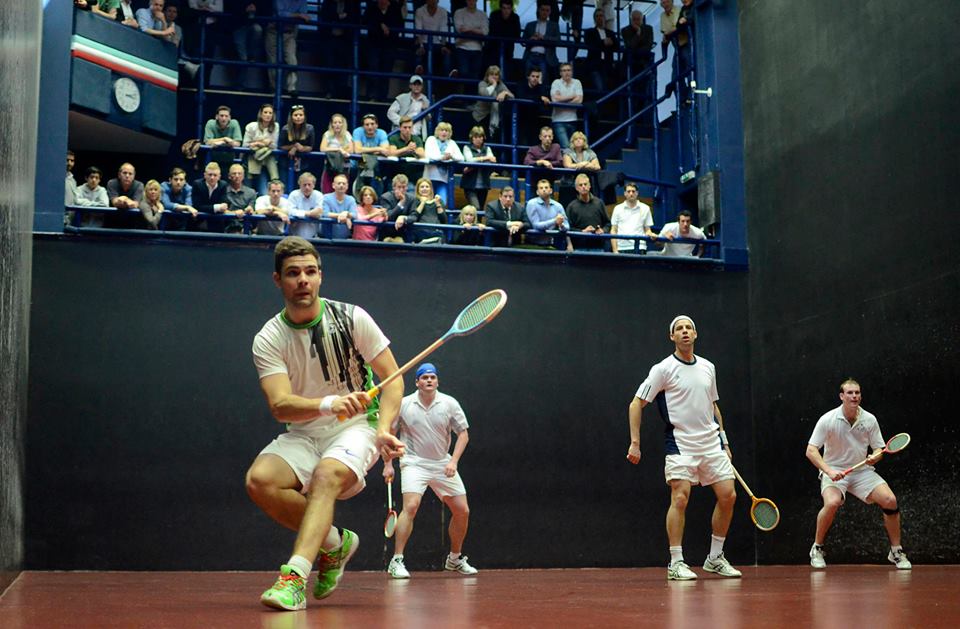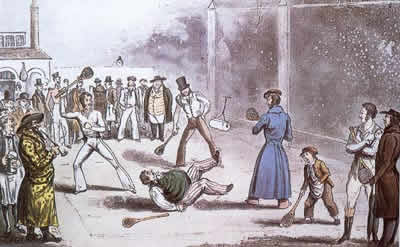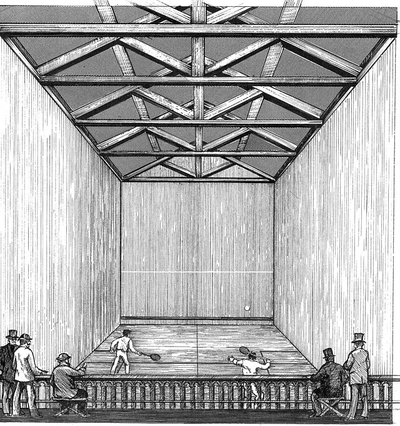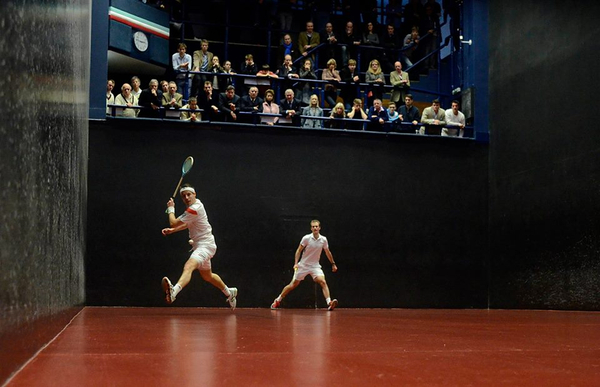
Rackets (England)
- Name of sport (game): Rackets
- Place of practice (continent, state, nation):
United Kingdom, United States and Canada
- History:
In its earliest form during the 18th Century, Rackets was played in the open on the walls of the yards of the two main debtor's prisons, the King's Bench and the Fleet. Gentlemen, imprisoned until they could find the wherewithal to repay their creditors, amused themselves with many different activities around the prison yard. These included skittles, fives, which was played both with the hand and a bat (as at Westminster School), and some brought tennis racquets with them and improvised against any convenient wall, sometimes with no side walls and always without a back wall.
There is mention of Rackets at the Fleet in a poem of 1749 and in John Howard's report on the state of prisons in England and Wales published in 1780. It is not until the early 1800s that Rackets becomes part of life outside the prisons. In his Book of Sports and Mirror of Life published by Pierce Egan in 1832, there is a long description of Rackets mentioning several open rackets courts other than the King's Bench and the Fleet. One of these was at the Belvedere Tavern, Pentonville, where most of the Open Court Championships were played. Others were to be found elsewhere in London, again at public houses, at the Eagle Tavern on the City Road, The White Bear Kennington, the White Conduit House, and the Rosemary Branch, Peckham.”
Source: https://www.wikiwand.com/en/Rackets_(sport)There are further records of courts at Bristol, Bath, Birmingham and Belfast. Egan states that if a gentleman sought a game at a tavern he would have to mix with those not of the highest rank in society. Implicit in this observation is that the debtors prison may have had a higher class of player (in both meanings of the word), and mention is made of a Major Campbell who was the best player in the King's Bench through having been incarcerated there for fourteen years. Spectators as well as prison visitors often came to watch matches in the prisons. Dickens mentions Rackets in the Pickwick Papers, as Mr Pickwick had the misfortune to be incarcerated in the Fleet. From Dickens' description the Fleet court appears to have had a front wall and one sidewall similar to a Jai Alai fronton. In 1814 there were four courts at the King's Bench and six Racket masters to look after them. Early courts outside the prisons had a front wall only, about 40 feet wide and 45 ft high.
Outside prisons and taverns, Harrow was the first school at which Rackets was played, probably from the early 1820s when the schoolyard was enlarged. When the first Lawn Tennis Championships were played at Wimbledon later in the century, Old Harrovian Rackets player Spencer Gore would win the singles.
Interior of the Eglinton Castle Rackets Hall in 1842.
Source: https://www.wikiwand.com/en/Rackets_(sport)In the middle of the 19th Century, Rackets played in covered courts began to predominate. The MCC built a court in 1844 next to the old Tennis court, and the old Princes Club opened in 1853 with several courts as well as two Tennis courts. The main competition court at Princes set the standard dimensions for most closed courts built from then up to the present day, being 60' long by 30' wide. Before this on the open courts, doubles was played on a court of 80' x 40' with two players playing up at the front of the court and two at the back.
Furthermore, and again about the middle of the 19th century, the growing popularity of the indoor game caused Rackets at the open courts attached to public houses to fall into desuetude. Rackets increasingly developed as a game for the wealthy. Although Lord West built a court at Buckhurst Park in Sussex in the 1850s and The Earl of Eglinton and Winton built one at Eglinton Castle, his home in Scotland, Rackets did not take off as a private country house game to the same extent as Tennis did later in the century.
Both Oxford and Cambridge universities had courts by 1855, the date of the first Varsity match. There were courts built at Torquay in 1859 and the first covered court at Harrow school, built in 1865. This has recently been reconstructured to create the Prenn Hue Williams Court.
Devonshire Park at Eastbourne included a Rackets court built in 1870 as part of its general recreational facilities. Between 1870 and 1890, courts were built at the new Princes Club, Manchester, Liverpool and in 1888 the courts at The Queen's Club were opened. - Description:
Rackets is played in a 30-by-60-foot (9.1 by 18.3 m) enclosed court, with a ceiling at least 30 feet (9.1 m) high. Singles and doubles are played on the same court. The walls and floor of the court are made of smooth stone or concrete and are generally dark in colour to contrast with the white ball. A player uses 30.5-inch (77 cm) wooden racket to hit a 38 mm (1.5 inch) hard white ball weighing 28 grams (1 oz). Championship quality Balls are made via two different sources. One such ball is manufactured in America using a machine developed by former Marlborough professional Bill Gordon and the other type is manufactured in England by former Winchester professional Peter Ashford. The Rackets ball is durable and can last for months at a time, however its outer covering (strong tape) has to be recovered regularly. With regard to the racket itself, as of February 2021, two companies produce rackets racquets, Grays of Cambridge (UK) and Gold Leaf Athletics (US).
In gameplay, a good stroke must touch the front wall above a 26.5 inches (67 cm) high wooden (often cloth-covered) board before touching the floor. The ball may touch the side walls before reaching the front wall. The player returning a good stroke may play the ball on the volley, or after one bounce on the floor. Gameplay is basically identical to squash, albeit without drop shots or lobs! The speed of the ball and tension of the racket strings used means that the play is fast, and potentially dangerous. Lets (replayed points) are common, as the striker should not play the ball if doing so risks hitting another player. Yet unlike in squash, strokes are not given if a player gets in the way such is the often exciting and frenetic gameplay. However, this danger is minimal, since the patient coaching all players receive engrain a solid tactical awareness in all participants. Matches are normally observed by a "marker" and a “referee”, who has the duty to call "Play" after each good stroke to denote that the ball is "up". Games are to 15 points, unless the game is tied at 13–all or 14–all, in which case the game can be "set" to 16 or 18 (in the case of 13–all) or to 15 or 17 (in the case of 14–all) at the option of the player first reaching 13 or 14. Only the server (hand-in) can score—the receiver (hand-out) who wins a rally becomes the server. Return of service can be extremely difficult, and, in North America, only one serve is allowed. At the top level of the game, aces (when a server beats their opponent without their opponent touching the ball) are somewhat rarer which results in physically draining rallies. Matches are typically best of five games, but earlier rounds of some tournaments can be best of 3 games - or even an adapted 'first to 30 points' game.
The main shots played are the volley, forehand and the backhand all similar to the way one plays these in squash. Yet, in recent years the game of rackets has incorporated much greater scope for innovation in the form of reverse angles and use of power rather than the more traditional use of placement and ‘cut’. In any case, the rules and scoring in squash have evolved in the last hundred years or so whereas Rackets has changed little; the main difference today is that players are now allowed brief rest periods between games. In the past, leaving the court could mean forfeiting the match, so players kept spare rackets, shirts, and shoes in the gutter below the ‘tin’ on the front wall! This was often cumbersome and the rules were changed to allow players to leave the court to change their racket mid-game and also to have a break between games. Continuous play is paramount and a game of singles or doubles is an exhilarating spectacle and guaranteed entertainment for participants and spectators alike.
Source: www.tennisandrackets.com/rackets/court-game/about
https://thesporting.blog/blog/2017/9/13/know-the-game-rackets - Current status:
The Neptune World Ranking System
The first official ranking list was created in Rackets in 2010/11 as an evolution of the Big-Red System and has been adapted to suit the current fixture calendar. The initial ranking system was sponsored by Neptune Investment Management, including both male and female competitors, and incorporated all tournament matches and assigned every player a nominal ‘ranking point’ rating which determined their position in the world. Players could win or lose points depending on their performance in the tournaments during a season, at which point at the end of the season a player was ‘re-calibrated’ (denoting an increase in points due to their participation in more than one tournament) or ‘eroded’ (reducing their number of points due to inactivity).
This system was refined over the summer of 2020 and many of the earlier inaccuracies and anomalies removed; and now needs further play to authenticate itself. This system is, however, slow moving in the top ten due to its source code being predicated on a zero-sum algorithm but is reasonably representative for those players below the top 15-20. Following reform of the World Challenge process a new Elite System was introduced in 2014/5 which is now used predominantly to seed major tournaments.The Elite System
In the Elite Ranking System, for both singles and doubles, players accumulate points individually and as a designated doubles partnership in specified Qualifying Tournaments (QTs) to determine their Elite World Singles Ranking, which would also be linked to their World Championship Challenge points standing.The singles ranking system has been refined in January 2021 to run over a rolling three-year cycle, with the current year carrying higher points than the previous year, itself higher than the year before. This add relevance to the ranking.
There are currently plans to evolve the doubles ranking system as an individual system, so a pair is the sum of its components. The finer details are still being defined.
Seeding for major tournament, including all QTs, are taken from the top of the Elite System, following by the Neptune World ranking System for those below the threshold.The World Challenge
Players and doubles partnerships accumulate points in a two-year Qualifying Period (QP), with the top ranked player/pair (excluding the holder/holders of the World Championship title) winning through to play in the World Championship. In recent years ‘eliminator’ matches have been used to determine a challenger for the world championship. An Eliminator (if necessary) and a Challenge Match are scheduled to take place every two years, but not where the current World Champion has won three out of the four US Opens and British Opens and one Tier 2 Qualifying Tournament in either North America or UK during the Qualifying Period and does not wish to defend. In the event that the reigning World Champion has won the requisite events to stave off a defense, it would be the choice of the existing champion to decide whether he/she would defend. The World Championship procedures have been refined in the 2010s to accommodate a fast-improving group of ‘world class’ players who are able to compete on the global tour.The Men’s World Championship (in both singles and doubles) is a best of seven game match played over two legs. The Women’s World Championship is a best of five game match where a potential challenger wins through to play against the reigning World Champion.
Source: www.tennisandrackets.com/rackets/court-game/ranking-procedures - Contacts:
The Tennis & Rackets Association
The T&RA Ltd
c/o The Queen’s Club
Palliser Road
West Kensington
London
W14 9EQ
Tel: 020 7835 6937
Fax: 020 7385 8920
Website: www.tennisandrackets.com
E-mail:This email address is being protected from spambots. You need JavaScript enabled to view it.
YouTube: www.youtube.com/channel/UCz4vpvhBrBB-ZLFRzCxwBCA
Fb: www.facebook.com/tennisandrackets
Twitter: twitter.com/tra_ltd
- Sources of information :
- Gallery:

